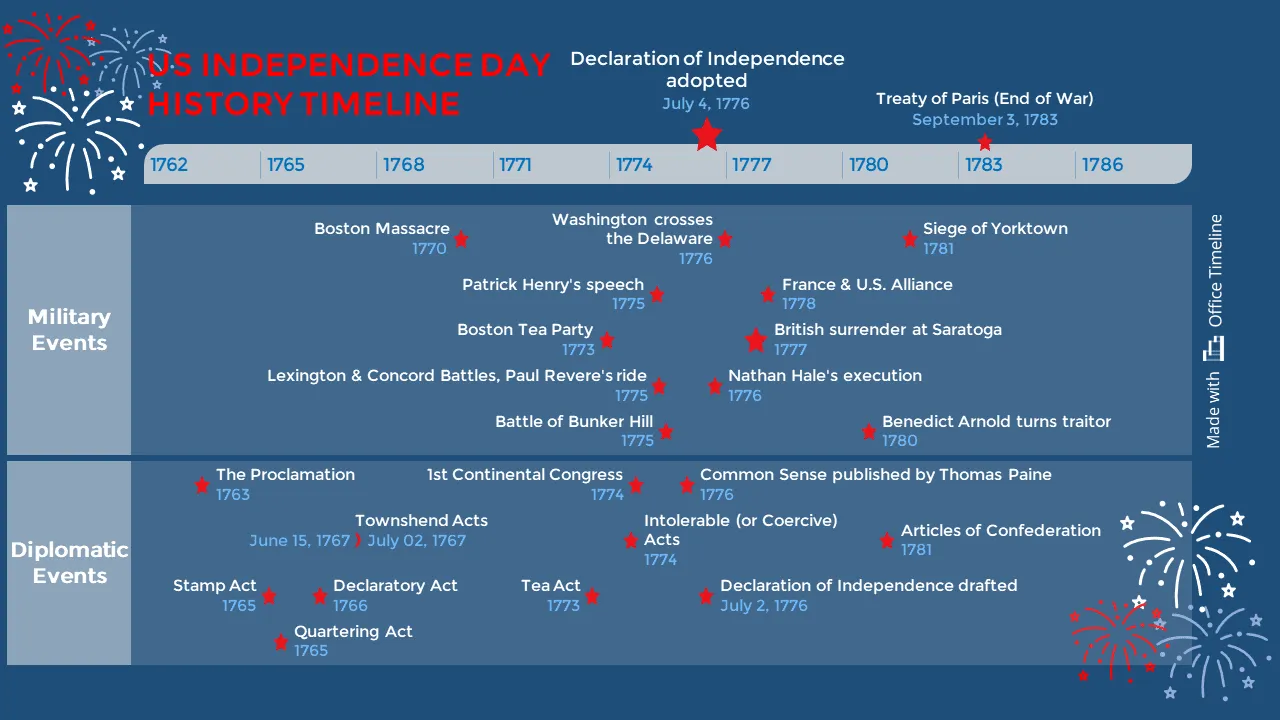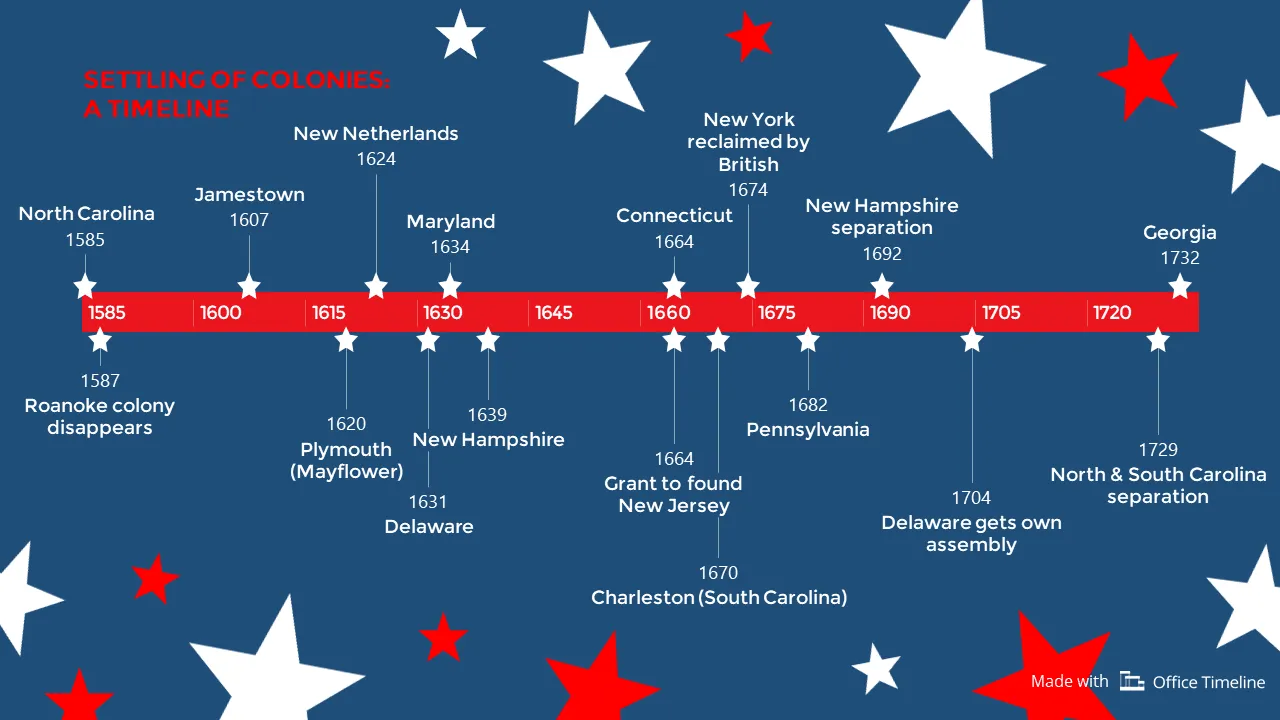US Independence Day timeline
The Independence Day timeline explains the context that led up to the Declaration on Independence being adopted on 4th of July 1776.
Last updated on July 03, 2022
An official federal holiday since 1941, Independence Day (also known as the Fourth of July) commemorates the ratification of the Declaration of Independence by the Second Continental Congress on July 4, 1776. Through this historic document, the Thirteen Colonies on the Atlantic coast of North America declared they were no longer subject to the British monarchy, but acted now as united, free, and independent states.
Since then, July 4th has been celebrated as the birth of American independence through festivities that range from fireworks, parades, baseball games and concerts to more casual family reunions, fairs, and picnics.
To honor this important event, we created this blog post which includes an abridged visual timeline of the US Independence Day history, as well as the answers to the most popular questions about the holiday.
History of US Independence Day: a timeline
- 1763: The Proclamation
- 1765: The Stamp and Quartering Acts
- 1766: The Declaratory Act
- 1767: The Townshend Acts
- 1770: The Boston Massacre
- 1773: The Boston Tea Party and Tea Act
- 1774: The First Continental Congress
- 1774: The Coercive Acts
- 1775: Patrick Henry’s speech
- 1775: The Lexington and Concord battles, Paul Revere’s ride
- 1775: The Battle of Bunker Hill
- 1776: George Washington’s crossing of Delaware
- 1776: “Common Sense” by Thomas Paine is published
- 1776: Nathan Hale’s execution
- July 2, 1776: The Declaration of Independence is drafted
- July 4, 1776: The Second Continental Congress ratifies the Declaration of Independence
- 1777: The colonists’ victory against the British at Saratoga
- 1778: The US ally with France
- 1780: Benedict Arnold’s treason
- 1781: Articles of Confederation are approved as first frame of government for the US
- 1781: the Siege of Yorktown
Bonus timeline: the 13 American colonies in order of founding
The first colony to be founded by English settlers on the North American territory was on the Roanoke Island, off the coast of North Carolina, in the 1580s. The settlers stayed for a year then returned home. A second group arrived here in 1587, but they mysteriously disappeared.
Over the course of the next century, the English established 13 colonies: Virginia, Massachusetts, Rhode Island, Connecticut, New Hampshire, New York, New Jersey, Pennsylvania, Delaware, Maryland, North Carolina, South Carolina, and Georgia.
Get a quick view of the chronological order in which the first English colonies were founded on American soil with our condensed visual timeline below:
FAQs about US Independence Day
Get a concise overview of the most relevant facts about US Independence Day with the help of our short answers to the most frequent questions asked on the topic.
On July 4th, 1776, the delegates from the Thirteen Colonies in America that united in the American Revolutionary War met and unanimously adopted the Declaration of Independence within the Second Continental Congress. Drafted by Thomas Jefferson and voted for approval two days earlier, the historic document announced the colonies’ separation from Great Britain.
Issued by King George III on October 7, 1763, the Royal Proclamation of 1763 was a British-produced decree that prohibited Anglo-American colonists from settling west of the Appalachian Mountains. It followed the Treaty of Paris – a formal agreement which officially ended the Seven Years’ War and based on which Great Britain acquired lands in the aforementioned region from the French.
The Proclamation was issued in an effort to keep control over the already challenging thirteen English colonies. The British considered that if Americans crossed the mountains, it would become too cumbersome to regulate trade and taxes. Furthermore, the territory that Great Britain gained from France (that is, the Ohio Valley) was still populated by French settlers who didn’t give up their claims to land or trade routes.
The British government thus tried to prevent American colonists from crossing the Appalachians to avoid the emergence of new tensions and a new war. However, the exclusion of the American colonists from the vast region of Trans-Appalachia created strong discontent and would become a catalyst to the American Revolution.
Full-out war with the British and emancipation from the Empire’s rule came after years of oppression and ever-growing taxes imposed on the colonies. One such tax is the 1765 Stamp Act, which the British Parliament passed in an attempt to counterbalance the massive debt left in the wake of the war with the French. The Stamp Act was followed two years later, in 1767, by a series of taxes – the Townshend Acts – passed between June and July, on goods imported from Britain.
The Boston massacre was a confrontation that took place in Boston on March 5, 1770. The existing tensions between the Anglo-American colonists and the British culminated with this event, when soldiers opened fire on a crowd of Boston citizens taunting them. The Brits eventually decided to withdraw their army before the conflict escalated.
The Tea Act was a law set in place by Britain on May 10, 1773, which granted the sole right to trade and deliver tea in the American colonies to the East India Tea Company.
Taking advantage of the fact that tea was the most popular drink among the American colonists, the Tea Act was designed to help the now struggling East India Company, whose majority stakeholders were members of the British Parliament. It allowed the tea to be exported directly to America, instead of having it imported to Britain and re-sent to the colonies.
It also helped the East India Company to sell its goods exclusively to chosen merchants in the American colonies, which undercut the business of local suppliers.
The Boston Tea Party was a political protest organized by American colonists on December 16, 1773, at Griffin’s Wharf in Boston, Massachusetts. Outraged by the Tea Act and angry at Britain for imposing “taxation without representation”, the radicalized part of the colonists – the Sons of Liberty – responded by donning Mohawk disguises, boarding three of Britain’s ships docked in Boston Harbor and destroying over 90 thousand pounds of tea.
The Coercive Acts were a set of laws passed by the Brits in 1774 to punish the Massachusetts colonists for the Boston Tea Party protest. These punitive measures imposed that:
- Boston Harbor remained closed until the colonies could pay for the damages caused by the Sons of Liberty.
- Full executive power in the colonies be granted to the British military governor Thomas Gage, with no town meeting being held without his direct approval.
- All British army officials could request their troops to be accommodated in uninhabited houses and buildings.
Being the first military engagements between British soldiers and American colonists, the Battles of Lexington and Concord are important as they mark the outbreak of the American Revolutionary War.
British military governor Thomas Gage is tasked with leading a small force to the town of Lexington, where he plans to capture John Hancock and Samuel Adams – two of the radicalized leaders of the Boston Tea Party. Upon descending into Lexington, the British force is met with a hail of lead fired by the 77-men Yankee militia force. It ends in disaster for the Brits: 73 casualties, 174 wounded and 25 MIA. The colonists lose only 7 people to this skirmish and continue to harass the retreating force all the way to Boston.
Meanwhile, legendary rider Paul Revere raced from town to town to finally reach Concorde to warn Americans about the impending invasion and convince them to rally in troops.
The Siege of Yorktown by the allied forces of the Yankees under the command of George Washington and the French army led by Rochambeau is one of the decisive victories in the war for independence. The British general Cornwallis and 7,000 of his soldiers surrender on October 19, 1781.
The Yankees and George Washington’s victory at Yorktown led up to a preliminary Anglo-American Peace treaty being signed in 1782, and a more comprehensive version of it – the Treaty of Paris– in 1783. The terms of the treaty state that Britain recognizes the independence of the US and a massive portion of the territory on the continent now belongs to the Yankees. It’s the dawn of a new day for the Americans, who have forged their legacy in blood, grit, and sacrifice.
About the Independence Day timeline
The Independence Day and US Colonies timelines were created with Office Timeline and are available to download as fully customizable PowerPoint slides. Office Timeline is an intuitive and versatile PowerPoint add-in that can help you create beautiful graphics like roadmaps, swimlane diagrams or Gantt charts within minutes. Download the free trial and find out how quick and easy it is to create or update your own historical timeline.
Project management tips and tricks
Turn project data into professional timelines
Get the advanced features of Office Timeline free for 14 days.




